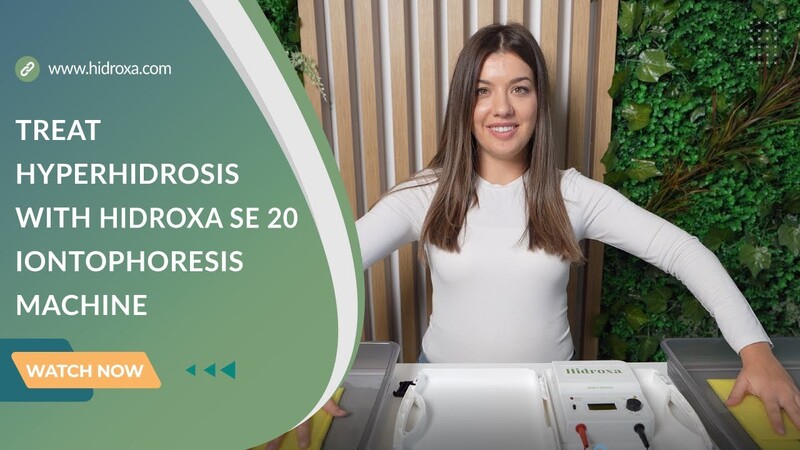Tap water iontophoresis: an effective treatment for hyperhidrosis
 Sandra E Mirkovic, MD
Sandra E Mirkovic, MD
Hyperhidrosis, or excessive sweating, can be a distressing condition that affects many individuals' quality of life. Far more intense than normal sweating, it's an overactive response of the sweat glands, often occurring independently of heat or physical activity. This condition leads to both physical discomfort and significant emotional distress.
The consequences of hyperhidrosis extend to social and professional areas, impairing self-confidence and complicating everyday interactions such as shaking hands or choosing clothes. It's not just the physical symptoms that are challenging; the condition often brings a sense of stigma and misunderstanding, leading to social withdrawal and reduced quality of life. Many people constantly look for effective treatments, showing how much this condition affects their lives. This highlights the importance of solutions like iontophoresis, which bring hope and help them regain control.
Thankfully, there are various solutions available to manage this condition, and one particular method that has gained significant attention is tap water iontophoresis.
Iontophoresis is a safe and effective treatment regime for hyperhidrosis, specifically for the treatment of palmar hyperhidrosis (excessive sweating of the hands), plantar hyperhidrosis (excessive sweating of the feet) and axillary hyperhidrosis (excessive sweating of the underarms). This non-invasive procedure aims to reduce excessive sweating by inhibiting the sweat glands' activity.
Discovering tap water iontophoresis
For those battling hyperhidrosis, discovering tap water iontophoresis can be a pivotal moment. This treatment, which passes a mild electrical current through tap water to target sweat glands, offers a non-invasive and effective remedy. It's particularly appealing for those who have found little success with other treatments. Unlike surgeries or medications, iontophoresis is safer and more accessible.
People usually find out about this solution through healthcare providers, online resources, or personal recommendations. This discovery often brings a sense of relief and hope, as it offers a way to manage a condition that has been a persistent source of stress.
This method has a strong track record of reducing excessive sweating in up to 90% of the cases, helping individuals regain confidence and comfort in social and professional settings. It addresses both the physical and psychological aspects of hyperhidrosis, empowering sufferers to lead more assured lives.
The science behind anti-sweat machine
Iontophoresis method involves the use of electrical current applied to the affected area, in this case, the hands, using a specialized device, a so -called iontophoresis device. The device consists of water containers where the hands are submerged, and an electrical current is passed through the water. While the electrical current in iontophoresis helps transfer ions into the sweat ducts, thereby reducing sweat production, the precise mechanism of action behind this effect is still not fully understood. It has been thought that the method helps form a mechanical block in the ducts of the sweat glands. Another theory is that the nerve cells connected with the sweat glands are modified.
Clinical studies have shown promising results regarding the effectiveness of utilizing tap water as a solution for managing excessive sweating.In a study conducted by Dogruk-Kacar et al., a statistical analysis revealed that tap water iontophoresis led to a significant reduction in both subjective sweating and objective measurements of sweating. The study design consisted of an initial phase of daily treatments over a span of three weeks, followed by maintenance treatments twice a week to achieve sufficient control. The main evidence for the success of iontophoresis is clinical experience. These devices have been used for decades to treat hyperhidrosis in many countries.
One of the main advantages is its safety profile. Unlike some other treatment options for hyperhidrosis, such as anticholinergic medication or topical corticosteroids, iontophoresis does not pose a risk of systemic side effects. Moreover, patients have reported minimal discomfort during the procedure, indicating a high level of tolerance towards it.
Emily’s personal story: Life before and after iontophoresis
One of the most compelling aspects of tap water iontophoresis is the personal stories of those who have discovered and benefited from this treatment. Take, for example, the story of Emily, a young professional who had been battling hyperhidrosis since her teenage years.
Her journey with hyperhidrosis was marked by an endless search for solutions. She had tried everything from clinical-strength antiperspirants to prescription medications, but nothing seemed to offer lasting relief. Each new product or method brought a glimmer of hope, only to lead to disappointment as her symptoms persisted. The constant worry about sweat stains and social embarrassment was taking a toll on her personal and professional life.
The turning point for Emily came during a routine visit to her dermatologist. It was here that she first heard about iontophoresis. Skeptical yet desperate for a solution, she decided to give it a try. The process was surprisingly simple: submerging her hands and feet in trays of water through which a mild electrical current was passed. It was a far cry from the invasive procedures and harsh chemicals she had tried in the past.
To Emily's amazement, after a few weeks of regular iontophoresis sessions, she began to notice a significant reduction in her sweating. The treatment, which initially seemed like just another attempt in a long line of trials, turned out to be the solution she had been searching for. For the first time in years, she felt like she could shake hands, wear whatever she wanted, and engage in social situations without the shadow of hyperhidrosis looming over her.
Emily's story is not unique. Many individuals have stumbled upon this anti-sweat solution after years of struggling with hyperhidrosis, only to find that it offers the effective and sustainable relief they had long hoped for. These personal stories underscore not just the physical effectiveness of the treatment, but also the emotional relief and renewed confidence that comes with gaining control over hyperhidrosis.

The iontophoresis procedure: A step-by-step guide
The iontophoresis procedure is quite advanced scientifically, yet it's easy and straightforward to carry out. Below is a simple guide that explains how this treatment is performed:
- Setup preparation: The iontophoresis device typically consists of two shallow trays connected to a low-voltage power source. These trays are filled with water – either tap water or mineral water, depending on the mineral level of the local tap water.
- Combining medication with iontophoresis: In certain cases, medication is added to the water to enhance the treatment's effectiveness. These medications, prescribed by a healthcare professional, can increase iontophoresis's efficiency in reducing sweat production.
- Initiating the procedure: To start the treatment, the affected body part, usually hands, feet, or underarms, needs to be submerged in the water-filled trays. The device is then turned on, allowing a mild electrical current to pass through the water. This current is usually adjustable to ensure comfort.
- Duration and frequency: A typical session lasts about 20 to 40 minutes, and initial treatments are often conducted three times a week. Once desired results are achieved, the frequency can be reduced to maintenance sessions, usually once a week or biweekly.
- Aftercare: Post-treatment, applying a moisturizer can help if any dryness or irritation occurs.
The simplicity and convenience of the iontophoresis procedure make it a favorable option for home use. Additionally, the ability to combine tap water iontophoresis with medication allows for a tailored approach to suit individual needs, further enhancing the treatment's effectiveness.
Iontophoresis testimonials
User testimonials highlight positive experiences, with many reporting substantial relief from sweat-related issues and an overall enhancement in their daily living.
Comparing iontophoresis with other hyperhidrosis treatments
Iontophoresis offers a unique approach to treating hyperhidrosis, setting it apart from other conventional methods like antiperspirants, medications, injections, and surgery.
- Antiperspirants: While over-the-counter and prescription antiperspirants are often the first line of defense, they may not be effective for severe hyperhidrosis and can cause skin irritation.
- Medications: Oral medications can reduce sweating but often come with systemic side effects, such as dry mouth, blurred vision, and urinary problems.
- B. toxin injections: They offer temporary relief but require repeated sessions and can be painful and costly.
- Surgery: Surgical options, such as endoscopic thoracic sympathectomy, are usually considered a last resort due to their invasive nature and potential for significant side effects like compensatory sweating.
In contrast, tap water iontophoresis is a non-invasive procedure with a much lower risk of side effects. It provides a safe and effective alternative, especially appealing for those seeking a less aggressive approach to managing hyperhidrosis.

Practical considerations: Frequency and additional tips for using iontophoresis treatment
When using tap water iontophoresis for hyperhidrosis treatment, there are practical considerations to keep in mind, particularly regarding treatment frequency and maintenance.
- Water quality: The mineral content of the water can affect the treatment's efficacy. If using tap water, ensure it's not too soft, as minerals are necessary for effective ion transfer. If needed, mineral supplements can be added to the water.
- Device maintenance: Regularly clean the iontophoresis device and trays to ensure optimal performance and hygiene as well as to avoid corrosion.
- Skin care: Before starting a session, make sure your skin is clean and free from any wounds or irritations. After the treatment, gently pat the skin dry and apply a moisturizer if you experience dryness.
- Adjusting current levels: Start with a lower current and gradually increase it to a comfortable level. If you feel any discomfort, reduce the current intensity. Pulsating current is often more comfortable than constant current.
- Consistency is key: Regular and consistent treatment is essential for the best results. Skipping sessions can lead to a return of excessive sweating.
- Consultation and follow-up: Regular check-ins with your healthcare provider can help adjust the treatment plan as needed and address any concerns.
By adhering to these recommendations and tips, individuals can maximize the benefits of iontophoresis and effectively manage their hyperhidrosis symptoms.
FAQs about tap water iontophoresis
The cost of tap water iontophoresis can vary. It includes the initial investment in the device, which ranges depending on the model and features. Usually 400-600 Euros. Some health insurance plans may cover part of the cost, but it's advisable to check with your provider. In Europe some public healthcare systems cover the devices.
Yes, iontophoresis devices are readily available and can be purchased online or through medical supply stores. Some dermatologists or healthcare providers may also offer them.
Most users start seeing a reduction in sweating within 1-2 weeks of starting treatment. However, it varies from person to person, and consistent use is key to achieving the best results.
After the initial phase, when sweat reduction is achieved, maintenance treatments are needed to sustain the results. The duration of effectiveness can vary, usually 1-2 weeks, but with regular maintenance, many users experience long-term relief.
Side effects are generally mild and can include skin dryness, irritation, or a mild tingling sensation during treatment. These can often be mitigated by adjusting the current level or using a moisturizer post-treatment.

Summary
With its ability to reduce excessive sweating and improve quality of life, tap water iontophoresis is known as an effective and safe procedure for treating hyperhidrosis, especially palmar hyperhidrosis. By following the prescribed treatment regime and using the appropriate water, individuals can experience significant improvements in their hyperhidrosis symptoms, leading to a more comfortable and confident life.